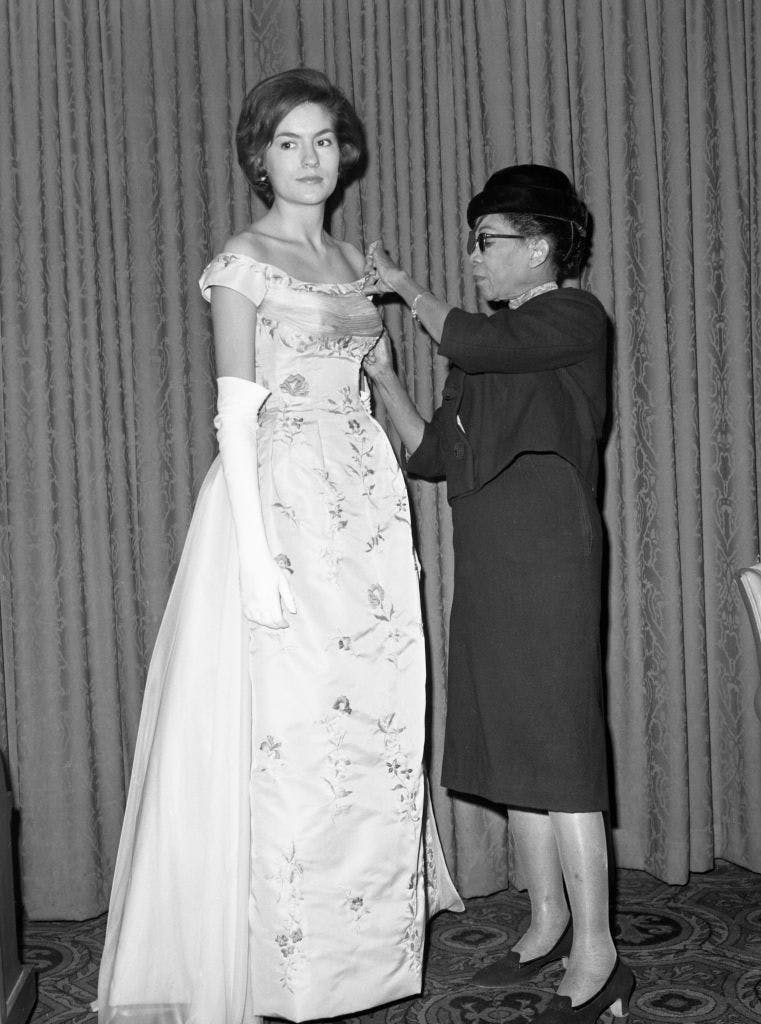When we think of fashion in the 1900’s, designers, Coco Chanel, Christian Dior, and Pierre Balmain are who we think of. But someone we tend to forget about as a society is the revolutionary designer Ann Lowe. Ann Lowe was an American fashion designer and notably the first African-American fashion designer. Her one-of-a-kind fashion was worn among prestigious society from the 1920s to 1960s and was responsible for New York City bourgeois style years. Despite being one of the most searched designers, Lowe was never able to establish a legacy in fashion since she was left out of discussions about the fashions of her period.
Lowe was always a gifted woman, as she was born into a family of seamstresses who had developed their own dressmaking business in Alabama. After the unfortunate death of her mother at the age of sixteen, Lowe took over her mother’s role in the business. She started receiving high commissions for dresses, and other clothing wears. Lowe completed a large order from the governor’s wife, establishing her as the new head of the family business in her mother’s place.
Her career had only been uphill from there, soon gaining a commission to create the iconic wedding dress of Jacqueline Bouvier for her marriage to President John F. Kennedy in 1953. Even though her garment is remembered as a beautiful gown that commemorated the grand wedding, the work and effort that went into it were not simple. A flooding in Lowe’s studio ten days before Bouvier’s wedding destroyed two months’ worth of labour and the upcoming President’s wife’s wedding gown. Lowe used her own expenses and enlisted extra help, ordered replacement fabrics and recreated the ivory silk dress with embroidered lace. Although Lowe spent her money and time on repairing the dress, the family still insisted that she bring the outfit in through the backdoor to avoid being seen. Lowe retorted back that if she were not allowed through the front door, she would “take the dress back.”Lowe was stripped of any public credit or proper monetary payment for her labour after the wedding.
Unfortunately, this specific after-math case became common in her career. You would think her name would be well-known with patrons like the DuPonts, Roosevelts, Posts, Biddles, Rockefellers, and Auchincloss. Although she was deemed as “Society’s best secret” the sugar-coated name belittled the racial segregation Lowe faced for being a black designer. She was underpaid by customers and had clients who were embarrassed to say their dress was made by a talented black woman. Actress Olivia De Havilland, who wore a dress designed by Lowe to the Oscars, is a prime example of how she undermined Lowe’s work by removing the back interior tag with Ann Lowe’s name on it. Lowe, on the other hand, never complained since she was more concerned with the production of her clothes than with generating a profit or a name for herself. It was only after the assassination of John F. Kennedy was Lowe rewarded with the title of being the designer behind Jacqueline Bouvier’s wedding dress. She began to appear in prominent magazines such as Vanity Fair and the Saturday Evening Post, which published editorials and stories on her fashion. Traditional fashion publications never gave importance to the lively fashion scene in the Black community, yet Lowe was able to break this barrier and have the press New York Age send her to Paris and have her stay at a luxury hotel.
Lowe continued her career until 1972, where she then retired and soon passed away in 1981. Today in our current society, it is important we recognize not only Lowe’s fashion, but the racial prejudice that was shown towards her, so that we reflect and remember the struggles and achievements Ann Lowe had gone through.
Bibliography
Adamiyatt, Roxanne. “A Black Couturier, Ann Lowe, Made Jackie Kennedy’s Wedding Dress.” Town&Country, 13 February 2021, https://www.townandcountrymag.com/style/fashion-trends/a35492692/ann-lowe-jackie-kennedy-wedding-dress/. Accessed 15 July 2021.
Jelen, Greta. “Remembering Ann Lowe, the Black Fashion Designer Who Made Jackie Kennedy’s Wedding Dress.” L’Officiel, 5 February 2021, https://www.lofficielusa.com/fashion/ann-lowe-jackie-kennedy-forgotten-black-fashion-designer. Accessed 16 July 2021.
McVicker, Michelle. “1898-1981 – ANN LOWE.” Fashion History Timeline, 4 August 2020, https://fashionhistory.fitnyc.edu/1898-1981-ann-lowe/. Accessed 13 July 2021.
Thurman, Judith. “Ann Lowe’s Barrier-Breaking Mid-Century Couture.” The New Yorker, 29 March 2021, https://www.newyorker.com/magazine/2021/03/29/ann-lowes-barrier-breaking-mid-century-couture. Accessed 13 July 2021.




With havin so much written content do you ever
run into any issues of plagorism or copyright violation?
My site has a lot of completely unique content
I’ve either authored myself or outsourced but it looks like a lot
of it is popping it up all over the web without my authorization. Do
you know any methods to help reduce content from being ripped off?
I’d really appreciate it.
As far as I know, we haven’t had to deal with plagiarism, so I’m not sure what to advise. I hope it does not occur again!
I need to to thank you for this great read!! I definitely loved every bit of it.
I have you book-marked to look at new things you post…
Thank you so much!
I just couldn’t go away your site prior to suggesting that I actually loved the standard information an individual provide on your guests?
Is gonna be again continuously in order to investigate cross-check new posts
Thank you for your appreciation, Chi!